mobile Ansicht, to the English Version tap the flag
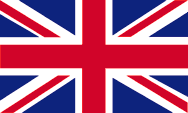

- Republik Mosambik
- präsidiale Republik
- Eigenbezeichnung: Républica de Moçambique
• Flagge
• historische Flaggen
• Bedeutung/Ursprung der Flagge
• Wappen
• Bedeutung/Ursprung des Wappens
• Flugzeugkokarde
• Landkarte
• Zahlen und Fakten
• Geschichte
• Ursprung des Landesnamens
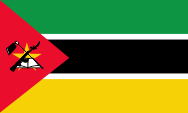
National-, Staats und Handelsflagge,
Seitenverhältnis = 3:5,
Quelle, nach: Corel Draw 4





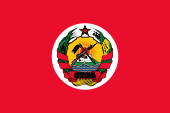
Flagge des Präsidenten,
Seitenverhältnis = 2:3,
Quelle, nach: Jam123, CC0, via Wikimedia Commons



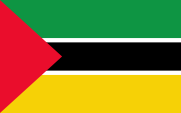
1962–1997,
Flagge der Partei FRELIMO,
Seitenverhältnis = 5:8,
Quelle, nach: Wikipedia (DE)



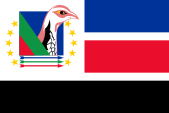
Flagge der Partei RENAMO,
Seitenverhältnis = 2:3,
Quelle, nach: Jolle, CC BY 3.0,
via Wikimedia Commons, Wikipedia (DE)




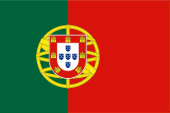
1911–1975,
Nationalflagge von Portugal,
Seitenverhältnis = 2:3,
Quelle: Corel Draw 4





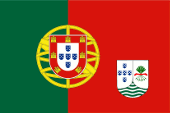
60-er Jahre 19. Jhd.,
geplante Flagge für Portugiesisch-Ostafrika,
Seitenverhältnis = 2:3,
Quelle: Wikipedia (DE)



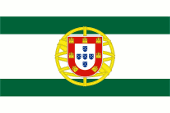
bis 1935,
Flagge eines Oberkommissars,
Seitenverhältnis = 2:3,
Quelle: Flaggenbuch 1939



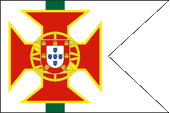
1935–1961,
Flagge eines Distriktskommandanten,
Seitenverhältnis = 2:3,
Quelle: Flaggenbuch 1939



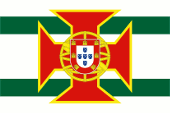
1935–1975,
Flagge des Generalgouverneurs,
Seitenverhältnis = 2:3,
Quelle: Die Welt im bunten Flaggenbild



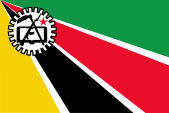
1975–1983,
Nationalflagge,
Seitenverhältnis = 2:3,
Quelle: Flaggen und Wappen




Die heutige Flagge von Mosambik wurde am 01.05.1983 eingeführt. Sie zeigt drei waagerechte Streifen in Grün, Schwarz und Gelb mit schmalen weißen Trennstreifen dazwischen. Am Liek ein gleichschenkliges rotes Dreieck mit einer vereinfachten Version des Staatswappens von Mosambik darin. Dieses Emblem besteht aus Hacke und Kalaschnikow-MP (AK-47), die sich kreuzen, sowie einem aufgeschlagenen Buch. Im Hintergrund ein gelber fünfzackiger Stern. Die Farben der Flagge scheinen heute folgendermaßen definiert zu sein, und zwar: Grün = Pantone 355, Rot = Pantone 185 und Gelb = Pantone 116. Die Farbe Grün steht für den fruchtbaren Boden, Rot für den Freiheitskampf, Schwarz für den afrikanischen Kontinent, und Gelb für die Bodenschätze des Landes. Die Flagge von Mosambik basiert auf der Flagge der FRELIMO-Bewegung (Frente de Libertaçao de Moçambique). Diese durfte bereits ein Jahr vor der Unabhängigkeit neben der portugiesischen Flagge gehisst werden. Bei der Schaffung der Flagge der FRELIMO stand wiederum die Flagge des südafrikanischen ANC Modell. So zeigte die FRELIMO-Flagge die ANC-Farben Grün, Schwarz und Gelb, dazu weiße schmale Trennstreifen und ein rotes Dreieck am Mast. Die für das unabhängige Mosambik am 25.06.1975 eingeführte Flagge zeigte zwar ebenfalls diese Farben, jedoch in einer anderen Anordnung und mit einer vereinfachten Version des Wappens. Im Jahr 1983 soll kurzzeitig – für nur ein oder zwei Tage – eine auf dem Modell Flagge der FRELIMO basierende Flagge als Nationalflagge verwendet worden sein. Sie zeigte das Emblem der Flagge von 1975 vor einem großen gelben fünfzackigen Stern in dem roten Dreieck am Liek. In der Zeit als portugiesische Kolonie wurde ausschließlich die portugiesische Nationalflagge verwendet, da man die Kolonien als fester Bestandteil des Mutterlandes betrachtete, und nicht als Außenbesitzungen. Das bedeutete, das portugiesische Kolonien nie eigene Flaggen hatten, auch wenn es in den sechziger Jahren des 20. Jahrhunderts Bestrebungen gab Flaggen für die Kolonien einzuführen, indem man das Wappen der Kolonie in das fliegende Ende der portugiesischen Nationalflagge platzierte. Diese Pläne wurden jedoch nie realisiert. Im Jahre 1935 wurden für die portugiesischen Kolonien eigene Wappen eigeführt. Die Gestaltung unterlag einem gewissen Schema und so zeigte jedes Wappen neben einer lokalen Symbolik die fünf Quinas aus dem Wappen von Portugal und fünf grüne Wellen auf Silber. Als lokale Symbolik erschienen im Wappen von Portugiesisch-Ostafrika ein Pfeilbündel und ein Joch.
Quelle:
Flags of the World,
World Statesmen,
Volker Preuß

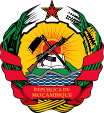
seit 1982,
Wappen von Mosambik,
Quelle: Jam123, CC0, via Wikimedia Commons

1935–1975,
Wappen von Portugiesisch-Ostafrika,
Quelle, nach: Wikipedia (D)

Das Staatswappen von Mosambik besteht in der heutigen Form seit dem September 1982 und zeigt vor dem Hintergrund eines gelben Zahnrads (Sinnbild der Industrialisierung) im unteren Teil des Wappens blaue Wellenlinien (Ozean) und eine grüne Landkarte des Landes. Darauf ein Buch (Sinnbild der Bildung), die aufgehende Sonne (Sinnbild des Neuanfangs) eine Hacke und eine Kalaschnikow-MP (AK-47), die sich kreuzen. Sie symbolisieren den Bauernstand und die wachsame Verteidigungsbereitschaft des Landes. Der gelbgeränderte rote Stern steht für die Unabhängigkeit und die politische Ausrichtung des Staates, den Sozialismus. Auf dem roten Band im unteren Teil des Wappens steht der Name des Landes in Portugiesisch. Das Wappen wurde in Details mehrfach abgeändert. Im Jahre 1935 wurden für die portugiesischen Kolonien eigene Wappen eigeführt. Die Gestaltung unterlag einem gewissen Schema und so zeigte jedes Wappen neben einer lokalen Symbolik die fünf Quinas aus dem Wappen von Portugal und fünf grüne Wellen auf Silber. Als lokale Symbolik erschienen im Wappen von Portugiesisch-Ostafrika ein Pfeilbündel und ein Joch.
Quelle:
Flaggen Wappen Hymnen,
Flaggen und Wappen der Welt,
Wikipedia (D),
Volker Preuß

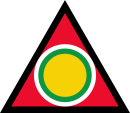
seit 2011,
Flugzeugkokarde,
Quelle, nach: Wikipedia (EN)
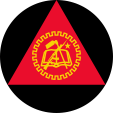
1975–2011,
Flugzeugkokarde,
Quelle, nach: Wikipedia (EN)

Lage:
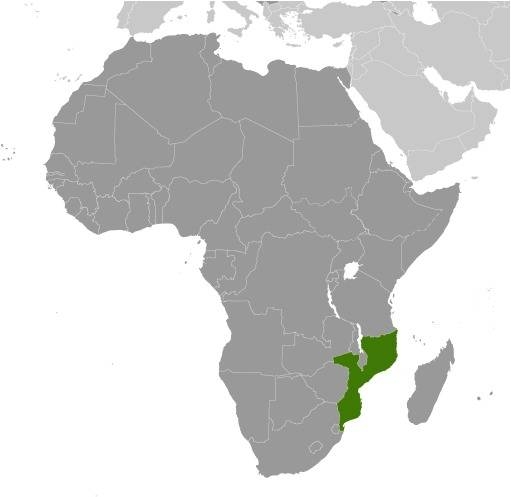
Quelle: CIA World Factbook
Landkarte des Landes:
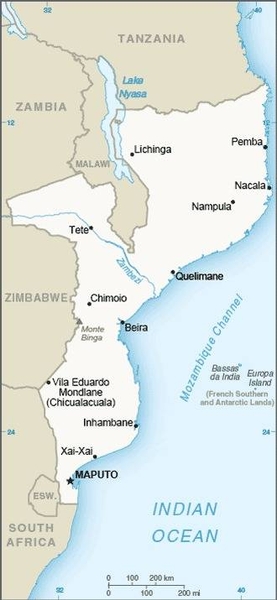
Quelle: CIA World Factbook

Fläche: 801.590 km²
Einwohner: 32.200.000 (2021), davon 98% Bantu, 1,5% Asiaten, 0,4% Portugiesen
Religionen: 28% Katholiken, 25% andere Christen, 18% Moslems, 12% Protestanten, 6% Animisten, 18% Nicht-Religiöse
Bevölkerungsdichte: 40 Ew./km²
Hauptstadt: Maputo (Lourenço Marques), 1.101.170 Ew. (2017)
Amtssprache: Portugiesisch
sonstige Sprachen: Bantusprachen, Suaheli
Währung: Metical (MZN, MTn) = 100 Centavos
Zeitzone: MEZ + 1 h
Quelle:
Wikipedia (D)

10./11. Jhd. · Araber gründen an der Küste die Handelsstützpunkte Quelimane, Sena und Sofala
14./15. Jhd. · Teile des heutigen Mosambik südlich des Sambesi gehören zum Reich Monomotapa (Simbabwe)
1498 · der portugiesische Seefahrer Vasco da Gama entdeckt und landet an der Küste des heutigen Mosambik
1505–1507 · Portugal erobert die arabischen Handelsstützpunkte und fast die gesamte ostafrikanische Küste bis nach Mogadischu (Somalia), in der Folgezeit lassen sich portugiesische Siedler vor allem am Sambesi nieder und erschließen das Land dem Flusslauf folgend, die Kolonie wird von Goa (Indien) aus verwaltet
1544 · Portugal besetzt die Delagoa-Bucht
17. Jhd. · Portugal kann im Süden des Landes sein Einflussgebiet vorübergehend auf die Territorien des zerfallenden Reiches Monomotapa ausdehnen, im Norden erreicht Portugal das Westufer des Malawisees
1604–1658 · die Niederlande gefährden die portugiesischen Besitzungen
1721–1730 · die Niederlande besetzen die Delagoa-Bucht
1752 · verwaltungsmäßige Trennung von Goa
1869 · Grenzvertrag mit dem Burenstaat Transvaal regelt den Grenzverlauf im Süden
1875 · Gründung von Lourenço Marques in der Delagoa-Bucht
1880 · Portugal verzichtet zugunsten Großbritanniens auf Teile seiner Einflussgebiete (Rhodesien, Malawi)
1885 · die Berliner Kongokonferenz bestätigt die portugiesischen Besitzungen in Portugiesisch-Ostafrika
1891 · Grenzvertrag mit Großbritannien regelt den Grenzverlauf zu Rhodesien und Malawi
1896 · Grenzvertrag mit dem Deutschen Reich regelt den Grenzverlauf zu Deutsch-Ostafrika
1920 · Angliederung des Kionga-Dreiecks an der Mündung des Flusses Rovuma (Teil von Deutsch-Ostafrika)
1951 · Portugiesisch-Ostafrika wird Überseeprovinz Portugals
1962 · Gründung der FRELIMO-Befreiungsbewegung in Tanganjika
1964 · Beginn des Guerillakampfes der FRELIMO, Teilerfolge im Norden des Landes
25.06.1975 · Unabhängigkeit, Proklamation der Volksrepublik Mosambik, Mosambik wird ein marxistischer Einparteienstaat unter der FRELIMO-Partei
1984 · Beginn des Guerillakampfes der RENAMO, Teilerfolge im Norden und Westen des Landes
1989 · Demokratisierung
1990 · neue Verfassung, Umbenennung in Republik Mosambik
1992 · Friedensabkommen zwischen RENAMO und FRELIMO
1994 · Wahlen, Sieg der FRELIMO
2000 · Unruhen von RENAMO-Anhängern
2013–2019 · Kämpfe zwischen RENAMO und FRELIMO
2019 · Friedensabkommen zwischen RENAMO und FRELIMO
Quelle:
Atlas zur Geschichte,
World Statesmen,
Discovery '97,
Wikipedia (D)

Der Name "Mosambik" geht auf den Namen der Stadt "Moçambique" im Norden des Landes zurück. Möglicherweise hat man sich als Landesnamen für den Namen Moçambique entschieden, weil diese Stadt in der Geschichte als Handelsplatz eine große Bedeutung hatte.
Quelle: Volker Preuß


![]()





















